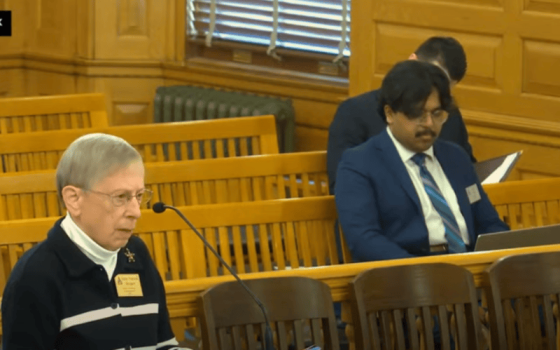YUCAY, Peru -- In the waning days of 2010, residents filled the streets of this tiny Andean town, showering a statue of Our Lady of the Nativity with flower petals and dancing in native costumes to usher in the new year.
But the dancers, many of whom were Quechua-speaking farmers, looked ahead with trepidation. Some worried that rainfall resembled last year's weather, when February floods triggered landslides, washed out roads and bridges, and destroyed crops. Some people who lost harvests last year could not afford to plant this year.
After the disaster, the Catholic Church stepped in with emergency aid and long-term development assistance. Church agencies did the same in other countries in the region: from Haiti, where an earthquake in January 2010 killed as many as 300,000 people and left nearly 2 million homeless, to Colombia, where recent floods overwhelmed five towns, killing 300 people and affecting another 2.2 million.
As Latin American church leaders look ahead to 2011, they expect to respond to more disasters, from droughts to flooding, that will threaten small farmers' livelihoods and trigger migration. They say the church must also speak out on such issues as violence, drug trafficking, environmental degradation, conflicts over natural resources, lack of jobs for young people and the region's persistent inequalities.
Environmental concerns rank high in the region, and experts expect to see more conflicts over natural resources. Mary DeLorey, strategic issues adviser for Latin America and the Caribbean for the U.S. bishops' Catholic Relief Services, predicts an expansion of mining and oil drilling, especially in Colombia, if political violence there continues to decrease.
Both industries and governments have their eyes on minerals, oil and timber in the Amazon basin.
"This is a time of serious social, environmental and cultural impacts in Amazonia," said Adda Chueca, director of the Amazonian Center for Anthropology and Practical Application in Lima, which supports the bishops in the Peruvian Amazon.
Drought caused water levels in the upper part of the Amazon River to drop to historic lows in 2010, while other parts of the region suffered flooding. Plans for expanded transportation networks, pipelines and hydroelectric dams increase the risk of deforestation and migration to the Amazon region, Chueca told Catholic News Service. Although studies in 2010 showed deforestation in Brazil had slowed, clearing continues, and forest fires burned more than 3.5 million acres of forest in Bolivia last year.
The nine countries that share the Amazon basin "have not made a real commitment to addressing climate change," Chueca said.
In Central America, climate change threatens farmers' livelihoods. In Nicaragua, where many small farmers grow coffee, a study by CRS and the International Center for Tropical Agriculture found the best yields and quality at an altitude of about 4,000 feet.
As the climate warms, however, experts expect the optimal altitude to increase to about 4,600 feet by 2020 and 5,200 feet by 2050, said Gaye Burpee, senior climate change adviser at CRS.
"The implication for the smallholder farmer who is using coffee as a cash crop is that (at 4,000 feet) their yields will go down," Burpee told CNS. "Livelihoods will be increasingly at risk."
When farmers barely make a living off the land, one bad harvest can drive them to cities in search of jobs. With employment opportunities scarce, many Central Americans head north toward the United States, often riding freight trains to Mexico.
That journey, always perilous, has turned deadly in recent years. The massacre of 72 migrants in the state of Tamaulipas, Mexico, in August 2010 made headlines throughout the region, but kidnapping of migrants for ransom has been a growing industry for criminal gangs in Mexico for about the past four years, said Axel Garcia of the Mexican bishops' human mobility ministry.
"This is an enormous challenge," he told CNS. "The level of violence and impunity is so great that the church will have to strengthen and prepare itself" to address the problem.
A study by the National Human Rights Commission in mid-2010 found that some 10,000 migrants had been kidnapped in the first half of the year. By the end of the year, the figure had climbed to 20,000. Nearly 250 cases involved between 50 and 100 victims at a time.
In many cases, the freight train on which the travelers are hitching a ride stops, armed gang members pull up in pickup trucks, throw the migrants into the trucks and take them to a house, Garcia said. Gang members contact the migrants' relatives in the United States, ordering them to wire ransom money to Mexico.
The captives are often beaten and sometimes killed. Women have been raped, and gang members sometimes brand them with hot metal rods, like cattle, marking them as gang property. Despite the dangers, Garcia said, the flow of migrants has not ebbed.
Experts say the U.S. Catholic Church could help by speaking out, warning migrants in the United States of the problem and urging them to take precautions, and pressuring wire-transfer companies like Western Union to ensure that money is not going to criminal gangs.
Drug-trafficking gangs are involved in the migrant kidnappings and killings, and bishops in the Andean countries are worried that drug-related violence is spreading in their jurisdictions, as well.
In a statement issued after a meeting in December, the presidents of the bishops' conferences of Peru, Ecuador, Colombia and Venezuela expressed concern about "the expansion of violence and disregard for human life, manifested in the rise of crime, murders, kidnappings and acts of terrorism. Drug trafficking and corruption are among the worst scourges our people suffer."
In November, Archbishop Tito Solari Capellari of Cochabamba, Bolivia, drew criticism from both government officials and farmers who grow coca, the raw material used to make cocaine, when he voiced concern about young people who are recruited for criminal activities by drug gangs.
Many countries in the region, particularly the Andean and Central American nations, still have relatively young populations -- what DeLorey calls a "youth bulge."
"There's not enough employment available for this large group of youth," she said, which makes them vulnerable to recruitment by gangs.
Underlying these problems is the region's persistent inequality, Archbishop Ruben Salazar Gomez of Bogota, Colombia, president of the Colombian bishops' conference, told CNS. Latin America has the most unequal distribution of wealth in the world, with indigenous people and those of African descent at the greatest disadvantage.
Amid the challenges they will face this year, church workers must "witness to the love of Jesus Christ," Archbishop Salazar said. "The church has no weapon besides the Gospel."




